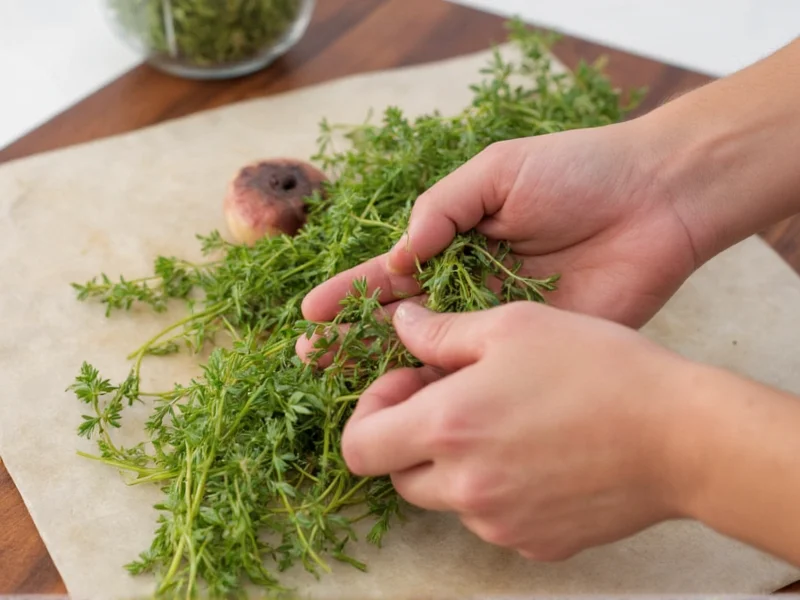Mastering the art of cutting fresh thyme preserves its delicate flavor and ensures healthy plant growth. Whether you're harvesting from your garden or preparing store-bought sprigs, the right technique makes all the difference in both culinary results and plant sustainability. This guide provides professional insights gained from decades of culinary herb management.
Essential Tools for Cutting Fresh Thyme
Having the right equipment ensures clean cuts that protect both the herb and your fingers. Professional chefs recommend these specific tools:
| Tool | Best For | Professional Tip |
|---|---|---|
| Sharp kitchen shears | Harvesting from live plants | Use bypass-style shears that make clean cuts without crushing stems |
| Chef's knife (6-8 inch) | Chopping harvested thyme | Maintain a slight angle for efficient rocking motion |
| Finger guard | Protecting fingers during chopping | Especially important when processing large quantities |
| Small bowl | Catching trimmed leaves | Prevents waste and keeps workspace clean |
Step-by-Step: Proper Fresh Thyme Cutting Technique
Follow these professional steps for optimal results whether harvesting or preparing thyme for cooking. The method varies slightly depending on your purpose.
For Harvesting Thyme from Live Plants
- Identify healthy stems with vibrant green leaves (avoid yellowing or flowering stems)
- Hold the stem firmly about 2 inches from the top with your non-dominant hand
- Position shears 4-6 inches below your grip point
- Cut at a 45-degree angle facing upward toward the stem tip
- Never remove more than one-third of the plant at once
- Harvest in the morning after dew has dried for maximum essential oils
For Preparing Store-Bought or Harvested Thyme
- Gather small bunches (5-6 stems) for efficient processing
- Hold the top 1-2 inches of stems firmly between thumb and forefinger
- Run your index finger downward along the stem to strip leaves
- Collect stripped leaves in a small bowl
- For fine chopping, gather leaves into a small pile
- Use a rocking knife motion with minimal pressure
- Chop just before use to preserve maximum flavor compounds
Advanced Cutting Techniques for Specific Culinary Uses
Different dishes require different thyme preparations. Understanding these variations helps maximize flavor impact:
- Whole sprigs for braising: Leave 2-3 inch sprigs intact to infuse liquids without creating small particles
- Fine chop for dressings: Mince extremely fine and mix with a pinch of salt to release oils
- Leaf separation for delicate dishes: Strip individual leaves for salads or garnishes where texture matters
- Stem utilization: Longer stems can be used in stocks but should be removed before serving
Critical Mistakes to Avoid When Cutting Thyme
Even experienced cooks make these common errors that compromise flavor and plant health:
- Using dull tools: Crushes stems instead of cutting cleanly, damaging cell structure and reducing shelf life
- Cutting against growth direction: Tears plant tissue, inviting disease and stunting future growth
- Over-harvesting: Removing more than 30% of the plant stresses the herb and reduces subsequent yields
- Chopping too early: Cutting hours before use allows volatile oils to evaporate, diminishing flavor
- Washing before cutting: Excess moisture makes leaves slippery and difficult to handle properly
Proper Storage After Cutting Fresh Thyme
Maximize shelf life with these professional storage methods:
- Short-term (2-3 days): Place stems in a glass with 1 inch of water, cover loosely with plastic bag, refrigerate
- Medium-term (up to 2 weeks): Wrap in slightly damp paper towel, store in airtight container in vegetable drawer
- Long-term (up to 6 months): Freeze whole sprigs in olive oil in ice cube trays, then transfer to freezer bags
Never store cut thyme in airtight containers without moisture control - this creates condensation that accelerates spoilage. Always label frozen thyme with date to track freshness.
Why Proper Cutting Technique Matters for Flavor
The way you cut fresh thyme directly impacts its essential oil release. Thyme contains thymol, carvacrol, and other volatile compounds that provide its distinctive flavor. Rough handling or improper cutting damages cell walls unevenly, causing inconsistent flavor release. Professional chefs understand that gentle, precise cutting preserves the herb's natural chemistry, delivering more balanced flavor in finished dishes.
Studies show properly handled thyme retains up to 40% more essential oils than roughly processed herbs. This difference becomes particularly noticeable in delicate preparations like vinaigrettes or custards where subtle herb notes should shine through without overpowering other ingredients.











 浙公网安备
33010002000092号
浙公网安备
33010002000092号 浙B2-20120091-4
浙B2-20120091-4